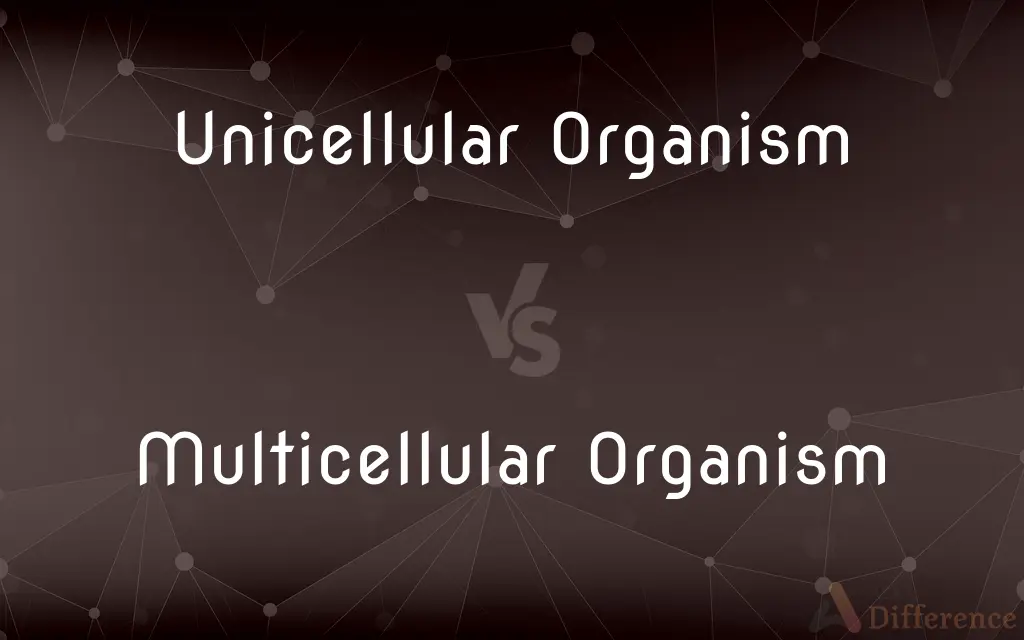Unicellular Organism vs. Multicellular Organism — What's the Difference?
By Tayyaba Rehman — Published on January 22, 2024
Unicellular organisms consist of a single cell performing all life functions, while multicellular organisms are composed of multiple cells with specialized functions.

Difference Between Unicellular Organism and Multicellular Organism
Table of Contents
ADVERTISEMENT
Key Differences
Unicellular Organisms are composed of a single cell that carries out all the functions necessary for life. Every activity, from reproduction to feeding, occurs within this one cell. On the other hand, Multicellular Organisms consist of numerous cells, often organized into tissues and organs, each specializing in specific functions like digestion, respiration, or reproduction.
The simplicity of Unicellular Organisms often allows them to thrive in extreme environments where more complex life forms cannot survive. In contrast, Multicellular Organisms can develop complex systems like nervous or immune systems, allowing them to adapt to various environments, but they often require more stable conditions to survive.
The size of Unicellular Organisms is usually microscopic, limited by their need to perform all life functions within a single cell. Multicellular Organisms vary greatly in size, from tiny organisms to massive beings like whales and redwood trees, made possible by their cellular specialization.
Unicellular Organisms include bacteria and most archaea, representing some of the earliest forms of life on Earth. In contrast, Multicellular Organisms include plants, animals, and fungi, showcasing a vast array of life forms with complex structures and behaviors.
Comparison Chart
Cellular Composition
Single cell
Multiple cells
ADVERTISEMENT
Cell Specialization
No specialization; one cell does everything
Specialized cells (e.g., nerve, muscle cells)
Size
Typically microscopic
Ranges from microscopic to very large
Examples
Bacteria, amoeba
Humans, trees, animals
Compare with Definitions
Unicellular Organism
Can inhabit extreme environments.
Some unicellular organisms thrive in hot springs or icy environments.
Multicellular Organism
Has cellular specialization and division of labor.
In a multicellular organism, nerve cells have a different role than muscle cells.
Unicellular Organism
A life form consisting of a single cell.
Amoebas are unicellular organisms that live in pond water.
Multicellular Organism
Varies in size, from small to very large.
Multicellular organisms range from small insects to large mammals.
Unicellular Organism
Often microscopic and simple in structure.
Unicellular organisms are invisible to the naked eye.
Multicellular Organism
Includes plants, animals, and fungi.
Trees, dogs, and mushrooms are examples of multicellular organisms.
Unicellular Organism
Performs all life processes within one cell.
A unicellular organism like a bacterium feeds and reproduces within the same cell.
Multicellular Organism
Composed of multiple, specialized cells.
Humans are multicellular organisms with different cells for different functions.
Common Curiosities
Are all multicellular organisms large?
Not all multicellular organisms are large; some, like certain algae and fungi, can be quite small.
What is a unicellular organism?
A unicellular organism is a single-celled life form that performs all life functions within one cell.
Do multicellular organisms have different types of cells?
Yes, multicellular organisms have different types of cells, such as nerve cells, muscle cells, and blood cells, each performing specific functions.
What environments can unicellular organisms inhabit?
Unicellular organisms can inhabit a wide range of environments, including extreme conditions like hot springs and polar ice.
Are humans unicellular or multicellular?
Humans are multicellular organisms.
What defines a multicellular organism?
A multicellular organism is composed of multiple cells that often specialize in different functions.
Can unicellular organisms be seen with the naked eye?
Most unicellular organisms are microscopic and cannot be seen without a microscope.
What is an example of a unicellular organism?
An example of a unicellular organism is E. coli, a type of bacterium.
Can multicellular organisms be unicellular at any stage?
Some multicellular organisms, like certain algae, can have unicellular stages in their life cycle.
How does cell specialization benefit multicellular organisms?
Cell specialization in multicellular organisms allows for more efficient functioning and adaptation to various environments.
What is the size range of multicellular organisms?
Multicellular organisms range in size from microscopic to organisms as large as whales or trees.
Are all plants and animals multicellular?
Almost all plants and animals are multicellular, but there are exceptions like unicellular algae.
Do unicellular organisms have specialized cells?
No, in unicellular organisms, the single cell performs all necessary functions.
Share Your Discovery

Previous Comparison
Western Digital Hard Disk vs. Seagate Hard Disk
Next Comparison
JPEG vs. PDFAuthor Spotlight
Written by
Tayyaba RehmanTayyaba Rehman is a distinguished writer, currently serving as a primary contributor to askdifference.com. As a researcher in semantics and etymology, Tayyaba's passion for the complexity of languages and their distinctions has found a perfect home on the platform. Tayyaba delves into the intricacies of language, distinguishing between commonly confused words and phrases, thereby providing clarity for readers worldwide.
















































